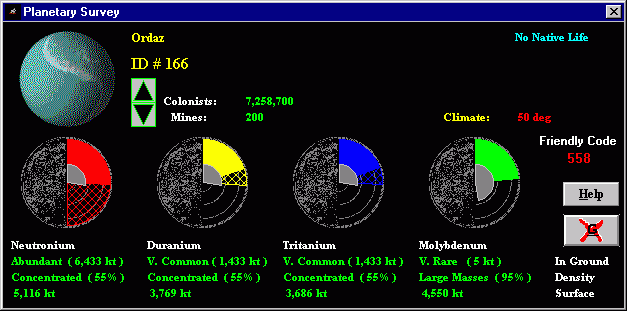
The Planetary Survey display: The little dots have been replaced with pie slices. There are now 3 different slice. The large hatched pie slice is the total amount of minerals on and in the planet. The solid pie is the amount on the planets surface. The maximum that the display will show is a half pie. Half a pie equals 10,000 kt.

The small grey pie in the center is the rate that minerals may be extracted from the ground (density). This pie ranges from nothing (0%) to half a pie (100% mineral density).
The mining survey will show you a graph of the amounts of minerals minerals remaining unmined in the planet's core and a listing of the amounts of ore that have been mined so far and are in storage, ready for use.
The survey will also tell you the number of mines present on the planet. The rate that your mines can extract ore out of the ground depends on the concentration of the ore. There are five grades of mineral concentration.
1. very scattered
2. scattered
3. dispersed ( three mines can extract a KT per turn )
4. concentrated
5. large masses ( one mine can extract a KT per turn )
The amount of minerals in a planet is rated at five
different grades.
1. none
2. very rare
3. rare
4. common
5. very common
6. abundant
Neutronium is the super dense mineral used for fuel on starships. It is far too unstable for use in building ship components.
Duranium is a very strong mineral used to build the frame work of starship components and the armor skin of starbases and fighters.
Tritanium is a mineral that can withstand very high pressures and temperatures. It is used widely in starship construction.
Molybdenum is used mainly in high power energy wave guides. It is important for weapon construction and engine construction. High tech components tend to use greater amounts of molybdenum than lower tech components.
The mining survey screen will also give a short report on any native races living on the planet.